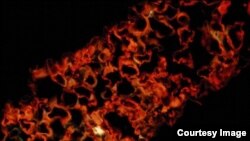Scientists have developed a promising treatment for Ebola hemorrhagic fever, a lethal disease spread by infected bats in western Africa. The experimental compound could become the first successful treatment for Ebola - even following the onset of severe symptoms.
Ebola hemorrhagic fever is 90 percent fatal. By the time most people suddenly come down with symptoms including high fever, severe headache, body aches and respiratory symptoms, little can be done to save their lives.
Scientists at the U.S. Army Medical Research Institute of Infectious Diseases have developed an experimental compound, however, that may change the prognosis.
Researcher James Pettitt says more than 40 percent of rhesus macaques were cured after they had already developed severe symptoms. They were given an intravenous treatment with MB-003.
In a prior experiment, the compound prevented symptoms in 100 percent of monkeys when given one hour after exposure.
This time around, Pettitt said investigators deliberately waited more than four days to treat the macaques because they wanted to see how well the compound might work in people who become desperately ill.
“We really tried to push the threshold of treatment here from a post-exposure drug to a true therapeutic to prove a patient in an outbreak situation was infected,” he said.
After exposure, the Ebola virus quickly reproduces and overwhelms the patient’s immune cells. But MB-003 inactivates the pathogen by targeting a protein on its outer surface, triggering the person’s natural immunity to kill infected cells.
Pettitt said the U.S. government is interested in the experimental drug because of Ebola’s potential use as a bioterror agent.
"That’s how it’s labeled by the [U.S.] Centers for Disease Control," he said. "So our mission here is to protect the war fighter from any potential outbreaks from this in any indigenous regions where they might be posted.”
Pettitt said researchers now want to try to increase the compound’s effectiveness, at the same time making sure it is safe and effective in humans.
An article on MB-003 as a potential treatment for infection with the Ebola virus is published in the journal Science Translational Medicine.
Ebola hemorrhagic fever is 90 percent fatal. By the time most people suddenly come down with symptoms including high fever, severe headache, body aches and respiratory symptoms, little can be done to save their lives.
Scientists at the U.S. Army Medical Research Institute of Infectious Diseases have developed an experimental compound, however, that may change the prognosis.
Researcher James Pettitt says more than 40 percent of rhesus macaques were cured after they had already developed severe symptoms. They were given an intravenous treatment with MB-003.
In a prior experiment, the compound prevented symptoms in 100 percent of monkeys when given one hour after exposure.
This time around, Pettitt said investigators deliberately waited more than four days to treat the macaques because they wanted to see how well the compound might work in people who become desperately ill.
“We really tried to push the threshold of treatment here from a post-exposure drug to a true therapeutic to prove a patient in an outbreak situation was infected,” he said.
After exposure, the Ebola virus quickly reproduces and overwhelms the patient’s immune cells. But MB-003 inactivates the pathogen by targeting a protein on its outer surface, triggering the person’s natural immunity to kill infected cells.
Pettitt said the U.S. government is interested in the experimental drug because of Ebola’s potential use as a bioterror agent.
"That’s how it’s labeled by the [U.S.] Centers for Disease Control," he said. "So our mission here is to protect the war fighter from any potential outbreaks from this in any indigenous regions where they might be posted.”
Pettitt said researchers now want to try to increase the compound’s effectiveness, at the same time making sure it is safe and effective in humans.
An article on MB-003 as a potential treatment for infection with the Ebola virus is published in the journal Science Translational Medicine.




